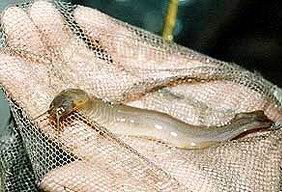Maybe the Spirits Editor can name a drink after this guy, too:

The most feared creature of any river traveler is the tiny, almost transparent catfish known as the candiru. This sharp-spined fish is the only other animal besides the vampire bat that is known to survive solely on blood. Most species of candiru are only about an inch long, and they usually make their living by swimming into the gill chambers of larger fish. To other fish, the candiru is relatively harmless, because, when full to capacity, it simply swims back out of the gill chamber and burrows into a riverbed to digest its blood meal. To humans, however, the miniature catfish is a potentially lethal menace.

When it comes to parasitizing people, a very rare occurrence, the candiru's modus operandi is to enter through an orifice - from a vagina to an anus. It is most famous, however, for wiggling its way into a urethra. The most widely discussed, if highly controversial, theory is that candirus are attracted to urine streams, mistaking them for the gill streams of fish. Before the unsuspecting bather knows what is happening, the candiru has followed the stream to its source, slipped inside, sunk its spines in the soft tissue, and begun to gorge on its host's blood. For the candiru, this is a fatal move. While it can easily swim out of a fish' gills, it cannot find its way out of a human urethra. Even if it could swim backward, its stiff spines prevent it from going in any direction but forward.

For the person whom the candiru has parasitized, the situation is potentially just as dire, and the cure can be as bad as the affliction. The candiru soon dies where it is, but its body continues to block the urethra, causing excrutiating pain and, if not removed, death. Candiru removal, however, is difficult, especially in remote locations. In 1897, George Boulenger, a Belgian ichthyologist and herpetologist, presented a candiru to the Zoological Society of London and related a gruesome story, told to him by a doctor named Bach, of the extreme measures to which men were willing to go in order to rid themselves of a candiru. "The only means of preventing it from reaching the bladder, where it causes inflammation and ultimately death, is to instantly amputate the penis," Boulenger told his no doubt horrified audience. "Dr. Bach had actually examined a man and three boys with amputated penis [sic] as a result of this dreadful incident." This was not the first, or the last, story of a penectomy performed on a man whose urethra had been blocked by a candiru.

Instances of candirus parasitizing people are rare, but in the one case in which a doctor fully documented his removal of a candiru from a young man, the victim's explanation of how the fish had entered his urethra was nearly as shocking as the fact that it was there at all. Up to that point, most scientists had assumed that, in order for the fish to find its way into a urethra, that part of the victim's anatomy had to be submerged in the water. In this case, however, the victim reported that, just before the attack, he had been standing in a river urinating, but the water had reached only to his upper thighs, and his penis had not even touched the river, much less been submerged in it. The candiru, he claimed, had abruptly leapt out of the water, shimmied up his urine stream, and disappeared into his urethra. He had made a desperate lunge for the fish, but it was too fast and too slippery. Local doctors had been at a loss to help the man, and by the time he was finally moved to a hospital for treatment, he had been unable to urinate for more than a week, and his stomach had become so distended that he looked six months pregnant. The doctor who eventually operated on him was able to successfully remove the candiru - without resorting to amputation.


The most feared creature of any river traveler is the tiny, almost transparent catfish known as the candiru. This sharp-spined fish is the only other animal besides the vampire bat that is known to survive solely on blood. Most species of candiru are only about an inch long, and they usually make their living by swimming into the gill chambers of larger fish. To other fish, the candiru is relatively harmless, because, when full to capacity, it simply swims back out of the gill chamber and burrows into a riverbed to digest its blood meal. To humans, however, the miniature catfish is a potentially lethal menace.

When it comes to parasitizing people, a very rare occurrence, the candiru's modus operandi is to enter through an orifice - from a vagina to an anus. It is most famous, however, for wiggling its way into a urethra. The most widely discussed, if highly controversial, theory is that candirus are attracted to urine streams, mistaking them for the gill streams of fish. Before the unsuspecting bather knows what is happening, the candiru has followed the stream to its source, slipped inside, sunk its spines in the soft tissue, and begun to gorge on its host's blood. For the candiru, this is a fatal move. While it can easily swim out of a fish' gills, it cannot find its way out of a human urethra. Even if it could swim backward, its stiff spines prevent it from going in any direction but forward.

For the person whom the candiru has parasitized, the situation is potentially just as dire, and the cure can be as bad as the affliction. The candiru soon dies where it is, but its body continues to block the urethra, causing excrutiating pain and, if not removed, death. Candiru removal, however, is difficult, especially in remote locations. In 1897, George Boulenger, a Belgian ichthyologist and herpetologist, presented a candiru to the Zoological Society of London and related a gruesome story, told to him by a doctor named Bach, of the extreme measures to which men were willing to go in order to rid themselves of a candiru. "The only means of preventing it from reaching the bladder, where it causes inflammation and ultimately death, is to instantly amputate the penis," Boulenger told his no doubt horrified audience. "Dr. Bach had actually examined a man and three boys with amputated penis [sic] as a result of this dreadful incident." This was not the first, or the last, story of a penectomy performed on a man whose urethra had been blocked by a candiru.

Instances of candirus parasitizing people are rare, but in the one case in which a doctor fully documented his removal of a candiru from a young man, the victim's explanation of how the fish had entered his urethra was nearly as shocking as the fact that it was there at all. Up to that point, most scientists had assumed that, in order for the fish to find its way into a urethra, that part of the victim's anatomy had to be submerged in the water. In this case, however, the victim reported that, just before the attack, he had been standing in a river urinating, but the water had reached only to his upper thighs, and his penis had not even touched the river, much less been submerged in it. The candiru, he claimed, had abruptly leapt out of the water, shimmied up his urine stream, and disappeared into his urethra. He had made a desperate lunge for the fish, but it was too fast and too slippery. Local doctors had been at a loss to help the man, and by the time he was finally moved to a hospital for treatment, he had been unable to urinate for more than a week, and his stomach had become so distended that he looked six months pregnant. The doctor who eventually operated on him was able to successfully remove the candiru - without resorting to amputation.

_______________
candiru avoidance techniques
~

No comments:
Post a Comment